The FSM telecommunications sector has five layers of key stakeholders:
- FSM Government (Department of Transportation, Communications and Infrastructure): Oversees the sector and sets telecommunication policy
- FSM Telecommunication Regulation Authority (TRA): We are the sector regulator responsible for ensuring fair competition and protecting consumer rights. You can read more about who we are and what we do in the About Us section of this website
- FSM Telecommunications Cable Corporation (CableCorp): The government-owned wholesale-only service provider in the FSM. CableCorp manages FSMs subsea fiber cables. It is also building an open-access fiber optic network to reach most households and businesses on FSM’s main islands. CableCorp is prohibited from providing retail services by law.
- Telecommunication service providers: Provide retail internet, phone, and mobile services to consumers. A list of active service providers is provided in section 4.2 and 5.2
- Consumers: The FSM general public who use and rely on telecommunication services.
1. Decide what type of service you will provide and how you will provide it
- This will determine what license(s) and access arrangements you will need
- Services include internet, mobile telephony, fixed telephony
2. Research local business requirements
- Understand what you need to operate a business in the FSM
- For example, consider the need for visas, licenses, registrations, and local premises
3. Register as a business
- You are required to be registered as a business to apply for a telecommunications license in the FSM
- You can access the application form here: https://www.roc.doj.gov.fm/index.php/services/forms
- Note the TRA is not involved in the registration process. If you need advice, contact the Registrar of Corporations here: Contact us (gov.fm)
4. Apply to the TRA for your telecommunications license(s)
There are three types of licenses you may need to apply for:
i) Individual license: This allows the person with the license to own network equipment and offer telecommunications services over that equipment
ii) Class license: This allows the person with the license to offer services over a network but not own the network equipment
iii) Spectrum license: You must apply for a spectrum license if you plan to offer mobile or fixed wireless services or use your own satellite for backhaul.
– You must specify the frequencies you want to use when applying for a spectrum license. You can find spectrum frequencies that are allocated for telecommunications use here: National Table of Frequency Allocation
– Spectrum already assigned to other licensees can be found here: Public Register of Licenses
– There are specific spectrum rules that govern spectrum operators; these can be found on this link: Spectrum Licensing Rules
▪ License applications can be made here: License Application Forms
– Use the operating license form if you're applying for an operating license to own or operate a Specific Communications Network (an Individual License) or if you're applying for a Communications Service (a Class license)
– New application fees are US$125 and Renewal application fees are US$100
▪ Note that some services are currently exempt from requiring a license, including:
– Services provided exclusively over an exempt network
– Voice and messaging services offered over the public internet that are not assigned telephone numbers by the TRA
– The provision of satellite capacity by foreign satellite providers
▪ Exemptions are periodically reviewed and may be removed
▪ You can contact the TRA here if you have questions about the licensing process or if you need assistance completing your license application.
5. Seek access arrangements
Telecommunication providers in the FSM can build their own network infrastructure or access existing infrastructure owned by other service providers.
In FSM, existing submarine cables connecting Pohnpei, Yap, and Chuuk, as well as FTTP networks in Pohnpei, Weno, and Yap, have been determined to be bottleneck facilities. The determination means that the owners of the bottleneck facilities are required, by law, to negotiate access to the infrastructure in good faith.
Read more about the bottleneck determination here: TRA Determination on Bottleneck Facilities
Therefore, if you are not building and using your own network, then you will need to arrange access to an existing network for:
– International connection
– Local terrestrial distribution
In FSM, your current options are:
International connectivity:
– CableCorp (subsea fiber: Guam-Pohnpei, Guam-Yap, Pohnpei-Chuuk)
– FSMTC (subsea fiber: Guam-Pohnpei)
– Satellite from a number of providers, including Kacific and Starlink
Local terrestrial:
– FSMTC (FTTP) (available on Pohnpei, Chuuk (Weno), Yap Proper)
– CableCorp (Open access FTTP) (Nationwide network currently under construction)
Access arrangement process:
i. Request access from existing providers
ii. If access is denied, or providers are unresponsive, contact the TRA for assistance
– The TRA has template access agreements that can be put in place through a determination process
– Note that licensees must first attempt negotiation in good faith on their own terms before approaching the TRA for assistance
– By law, providers receiving an access request are required to have made reasonable attempts to agree access within 30 days of receiving the request.
6. Seek interconnection arrangements
▪ If you are offering telephony (mobile or fixed) services, you will likely want to arrange Interconnection with existing telephony providers.
▪ Interconnection will allow your customers to connect locally to the customers of other providers, without incurring international call or SMS charges.
Current telephony providers in FSM:
▪ Mobile:
– FSMTC
– iBoom!
▪ Fixed:
– FSMTC
Interconnection arrangement process:
i. Request Interconnection from existing providers
ii. If Interconnection is denied, or providers are unresponsive, contact the TRA for assistance
– The TRA has template interconnection agreements that can be put in place through determination
– Note that licensees must first attempt negotiation in good faith on their own terms before approaching the TRA for assistance.
– By law, providers receiving an interconnection request are required to have made reasonable attempts to agree Interconnection within 30 days of receiving a request.
Population
The Federated States of Micronesia is a small nation consisting of just over 100,000 people and 607 Islands.
There are over 16,500 households in FSM, with an average size of 6 people. FSM is at the early stages of the process of urbanization, with about 22 percent of its population living in the urban areas on the main islands that include Yap Proper, Pohnpei Proper, Islands in the Chuuk Lagoon, and Kosrae.
The Federated States of Micronesia comprises four states: Yap, Pohnpei, Chuuk, and Kosrae. Chuuk State is the most populous state. The many islands in FSM are diverse and contain a range of geographical features, from mountainous islands to low-lying atoll islands. The diverse geography can make it difficult to deploy telecommunication services.
The following table outlines the population of FSM by state and the populations of the main islands:
| Category | Population |
|---|---|
| Population Total | 104,800 |
| Population by State | |
| Yap | 11,600 |
| Pohnpei | 36,900 |
| Chuuk | 49,600 |
| Kosrae | 6,700 |
| Population - Main Islands | |
| Yap Proper | 7,400 |
| Pohnpei Proper | 34,800 |
| Chuuk Lagoon | 36,100 |
| Kosrae | 6,800 |
GDP per capita
GDP (Gross Domestic Product) measures a country’s economic production. FSM’s agriculture sector contributes the largest share of its GDP, over 15 percent. The next largest contributors are wholesale and retail trade, accounting for 13 percent, and real estate and public administration, accounting for 12 percent each.
The following table outlines the GDP per capita in FSM.
GDP per capita
| Area | 2022 GDP Per Capita (USD) | |
|---|---|---|
| FSM
Yap State Pohnpei State Chuuk State Kosrae |
$2,694
$3,307 $3,821 $1,557 $3,399 |
|
Gross national income (GNI)
GNI per capita measures the total dollar value of everything produced by a country and the income its residents receive, whether it is earned at home or abroad. It can be used to measure and track a nation’s wealth yearly.
The following table outlines GNI per capita over the past 5 years.
GNI per capita
| Year | GNI per capita | |
|---|---|---|
| 2023
2022 2021 2020 2019 |
4,620
4,530 4,320 4,110 4,130 |
|
Penetration
The TRA monitors mobile penetration in the Pacific. We note two significant observations:
▪ FSM’s mobile use is low—At just 25 percent of the population, FSM has the lowest mobile use out of the countries we monitor
▪ FSM mobile use is not growing—In 2005, FSM performed reasonably well compared to similar countries. However, since then, all other compared countries have had significant growth in mobile use, except for FSM, which has stayed in the 20-30 percent range.
https://data.worldbank.org/indicator/NY.GNP.PCAP.PP.CD?end=2023&locations=FM&start=1990&view=chart

| Country |
|---|
| FSM |
| Tonga |
| Vanuatu |
| Kiribati |
| Samoa |
| Solomon Islands |
| Fiji |
| Grenada |
| 2005 | 2006 | 2007 | 2008 | 2009 | 2010 | 2011 | 2012 | 2013 | 2014 | 2015 | 2016 | 2017 | 2018 | 2019 | 2020 | 2021 | 2022 | 2023 |
|---|---|---|---|---|---|---|---|---|---|---|---|---|---|---|---|---|---|---|
| 13.28 | 17.67 | 26.27 | 26.56 | 26.71 | 26.74 | 26.68 | 29.87 | 29.64 | 25.15 | 20.67 | 21.24 | 18.00 | 17.78 | 18.77 | 20.35 | 25.85 | 25.94 | 25.20 |
| 29.60 | 29.55 | 45.35 | 48.82 | 51.02 | 52.22 | 53.11 | 54.51 | 56.50 | 67.31 | 72.92 | 79.10 | 97.00 | 99.00 | 100.00 | 106.00 | 106.60 | 106.70 | 107.40 |
| 6.06 | 7.00 | 11.85 | 16.02 | 57.19 | 71.94 | 56.44 | 58.55 | 49.58 | 59.14 | 64.48 | 78.54 | 86.00 | 90.00 | 116.00 | 115.00 | 103.10 | 102.80 | 100.40 |
| 0.70 | 0.74 | 0.78 | 1.01 | 9.82 | 10.29 | 13.17 | 16.92 | 18.54 | 27.42 | 36.96 | 46.21 | 20.00 | 21.00 | 47.00 | 52.00 | 54.00 | 54.20 | 50.80 |
| 13.35 | 25.16 | 47.24 | 47.24 | 47.24 | 48.40 | 53.04 | 52.37 | 55.42 | 62.28 | 77.63 | 68.00 | 72.00 | 72.00 | 73.00 | 73.40 | 73.90 | 67.20 | |
| 1.28 | 1.46 | 2.21 | 5.96 | 9.71 | 21.88 | 50.76 | 54.34 | 56.55 | 64.16 | 70.42 | 67.25 | 74.00 | 78.00 | 73.00 | 71.00 | 71.50 | 71.90 | 71.40 |
| 24.95 | 34.38 | 63.39 | 70.98 | 74.97 | 81.17 | 84.20 | 99.28 | 107.49 | 101.12 | 111.20 | 119.75 | 133.00 | 142.00 | 130.00 | 139.00 | 138.60 | 144.40 | 137.60 |
| 106.90 | 105.20 | 112.10 | 113.70 | 99.30 | 100.70 | 99.20 | 93.60 | 115.00 | 117.00 | 114.00 | 116.70 | 117.90 | 107.30 |
Source: 2005-2016 ITU, 2017-2023 Data Reportal
Number of Competitors
FSMTC and iBoom! are the mobile providers in FSM. FSMTC operates its mobile services across all main states, and several outer islands. iBoom! offers mobile services across Yap.
Mobile Service Providers:
| Service Providers | Locations Available | Services and Pricing Link |
|---|---|---|
| FSMTC | All main state islands. Outer islands: Pakin, Poluwat, Oneop, Onoun, Ahnd, Moch, Satowan, Pulap, Parem |
View FSMTC Plans |
| iBoom | Yap |
Plan 1 Plan 2 |
Traffic Data Trends:
Number of Cellular Mobile Subscriptions
The number of mobile subscriptions in FSM has been rising yearly since 2021. Mobile services are provided across all main islands and some outer islands, including Pakin, Poluwat, Oneop, Onoun, Ahnd, Moch, Satowan, Pulap, and Parem.
Number of Call Minutes
Mobile-to-mobile call minutes are significantly higher than mobile-to-fixed call minutes. This can be largely attributed to the growing prominence of mobile phones and fixed landlines becoming more obsolete as new technology is introduced.
Annual mobile call minutes
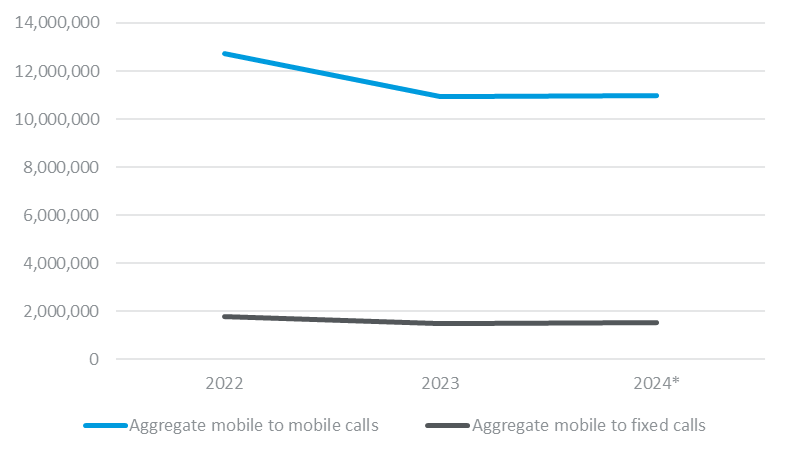
Source: Operator quarterly reports. The result for 2024 is a pro-rate estimate based on three-quarters of data.
Annual Mobile Call Minutes
| Year | Aggregate Mobile-to-Mobile Calls | Aggregate Mobile-to-Fixed Calls |
|---|---|---|
| 2022 | 12,744,450 | 1,761,752 |
| 2023 | 10,938,364 | 1,508,094 |
| 2024* | 10,965,980 | 1,520,256 |
*Incomplete year. The reported figure is an annual estimate based on three-quarters worth of data.
Number of SMS Sent
SMS, more commonly known as text messaging, is a type of text message sent between mobile phones.
Annual SMS sent

Source: Operator quarterly reports
*Incomplete year. The reported figure is an annual estimate based on three-quarters worth of data
Annual SMS Sent
| Year | SMS Sent |
|---|---|
| 2022 | 3,098,662 |
| 2023 | 2,226,798 |
| 2024* | 2,236,977 |
* Incomplete year. The reported figure is an annual estimate based on three-quarters worth of data.
Mobile Data Traffic
Annual mobile data traffic

Source: Operator quarterly reports
*Incomplete year. The reported figure is an annual estimate based on three-quarters worth of data
Annual Mobile Data Traffic
| Year | Megabytes |
|---|---|
| 2022 | 1,812,515,750 |
| 2023 | 2,025,042,000 |
| 2024* | 2,134,432,840 |
Aggregated data of all mobile providers
*Incomplete year. The reported figure is an annual estimate based on three-quarters worth of data.
In the FSM, Fixed Internet is provided through the following technologies:
i) ADSL
ii) VDSL
iii) Fiber Optic
iv) Satellite
Penetration
Fixed internet penetration in the FSM is relatively high when compared to most other similar countries, though still very low (below 10 percent). Comparison to Grenada shows the scale of improvement possible with a nationwide fiber to the premise (FTTP) roll out. CableCorp is currently in the process of rolling out a nationwide open access FTTP network across the main
Percentage of residents with fixed internet
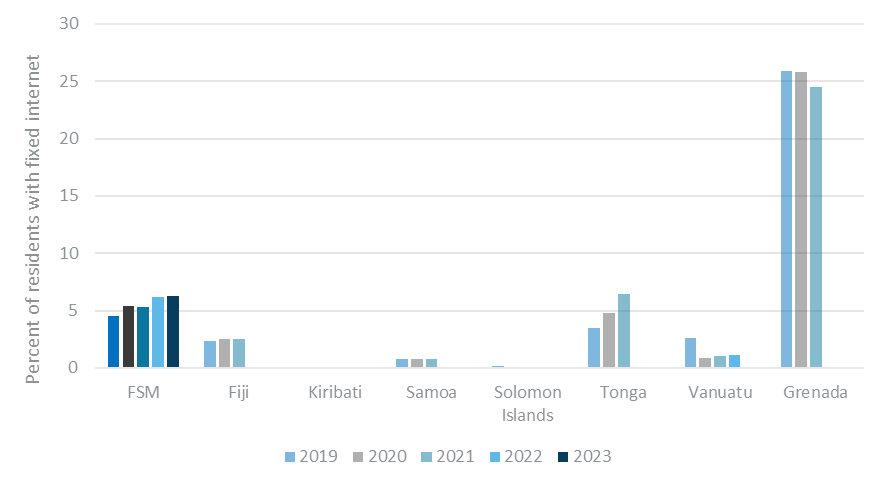
Percentage of residents with fixed internet
Annual Percentage Data by Country
| Country | 2019 | 2020 | 2021 | 2022 | 2023 |
|---|---|---|---|---|---|
| FSM | 4.50% | 5.40% | 5.30% | 6.18% | 6.30% |
| Fiji | 2.30% | 2.50% | 2.50% | — | — |
| Kiribati | 0.10% | 0.10% | 0.10% | 0.10% | — |
| Samoa | 0.80% | 0.80% | 0.80% | — | — |
| Solomon Islands | 0.10% | 0.10% | 0.10% | — | — |
| Tonga | 3.50% | 4.80% | 6.40% | 1.10% | — |
| Vanuatu | 2.60% | 0.90% | 1.0% | — | — |
| Grenada | 25.90% | 25.80% | 24.50% | — | — |
Number of competitors
Evolution of the FSM fixed internet market options

Competition in the FSM fixed internet market has been increasing over the last five years. There are now five competitors in the fixed internet market, including:
▪ Two fixed wired service providers:
– FSMTC
– iBoom!
▪ Three satellite service providers:
– Kacific
– MCS Pohnpei (a local reseller of international satellite services)
– Starlink
*FSMTCable is also known as OAE/CableCorp
This timeline includes active operators only. Other operators have been licensed but have not started providing services yet.
Terrestrial Fiber Facilities in FSM
Overview of facilities
Terrestrial fiber facilities are currently owned by:
- FSMTC
- iBoom!
FSMTC has rolled out FTTP networks on Chuuk, Pohnpei and Yap. iBoom! has fiber facilities on Yap.
CableCorp provides international and interstate wholesale-only connectivity. Read more about this below.
Future open access fiber
As part of the sector reform initiated in 2014, CableCorp (a government-owned, wholesale-only entity) is developing an open access fiber-to-the-premise (FTTP) network for the main islands of all four states of the FSM.
Once built, Internet Service Providers will be able to access CableCorp’s FTTP network to provide retail services for consumers. The reform specified areas of Chuuk, Kosrae, Pohnpei, and Yap that will get the FTTP network. These areas are known as the “deployment area”. CableCorp is prohibited from providing retail services by law.
CableCorp has completed the FTTP design and has started construction in Yap and Kosrae. Construction materials are arriving in Pohnpei and additional equipment to expedite the build is expected to arrive by the end of the year in each state. Significant progress on the construction will occur during 2025.
Current FTTP network
FSMTC owns and manages FTTP networks in Weno, Chuuk; Pohnpei; and Yap Propper. FSMTC’s FTTP networks are regulated and have been determined to be bottleneck facilities. FSMTC is, therefore, required to provide access to other licensees on fair terms.
iBoom! recently sought access to FSMTC’s fiber network in Yap. When initial discussions failed, the TRA stepped in and is in the process of determining a fiber access agreement for iBoom! iBoom! also has its own fiber network in Yap, which is in a point-to-point configuration.
FSMTC and iBoom have been expanding their fiber facilities in recent years. While not as expansive as the planned CableCorp network, the current facilities give us an indication of potential demand for fiber services in the FSM.
Status of current deployment
FTTP is difficult to access in FSM, and progress in expanding the fiber network has been slow over the past three years. However, the TRA expects the availability of the network to increase rapidly as construction of CableCorp’s open access FTTP network progresses in 2024 and 2025. FSMTC’s FTTP network is an encouraging sign of the potential for the future of the fiber rollout.
International Connectivity
International connectivity options
Current connectivity options
The FSM has two international subsea fiber-optic cable connections with Guam:
- The Pohnpei-Guam connection, using the HANTRU-1 cable
- The Yap-Guam “Yap Spur” connection, using the SEA-US cable.
FSMTC and CableCorp hold IRUs for the Pohnpei-Guam connection. CableCorp holds an IRU for the Yap Spur. CableCorp also owns and manages a subsea fiber-optic cable between Pohnpei and Chuuk. CableCorp is a wholesale-only entity set up to provide open access to local and international fiber for retailers who wish to enter the FSM market.
As the national wholesaler, CableCorp offers two types of services:
National Services
CableCorp will offer dark fiber services on its new open-access fiber network, allowing service providers to deliver services to end users, or connect their networks. Both shared fiber services for GPON and point-to-point services will be available, providing dark fiber connectivity to end users and service provider assets like mobile base stations. CableCorp will also offer ancillary services, such as colocation, to support service providers using the network.
International Connectivity Services
CableCorp offers layer 2 connectivity between Yap and Guam, Chuuk and Pohnpei, and Pohnpei and Guam. It is commissioning a new cable system (the East Micronesia Cable or EMC) to connect Kosrae to Pohnpei which is expected to be in service by the beginning of 2026. You can read more about the EMC here https://www.eastmicronesiacable.com/
CableCorp has also contracted to install a Starlink Gateway for Kosrae to act as additional capacity while the new subsea cable is being constructed.
Except for the Kosrae satellite service, CableCorp provides basic connectivity between its sites in each state and the Tata facility in Guam. Service providers must arrange their own IP transit or peering in Guam to access the internet. For more details, including information about the international network, service providers can contact CableCorp. CableCorp encourages providers to reach out and discuss their specific needs.
International wholesale pricing methodology
CableCorp manages and provides international and interstate wholesale capacity to Chuuk, Pohnpei, and Yap, and will provide it to Kosrae once the EMCS is completed.
Service providers in FSM can purchase wholesale international and interstate connectivity from CableCorp. CableCorp is required by law to provide connectivity through its assets on “non-discriminatory and cost-based terms”. As of October 2024, CableCorp has now finalized the methodology and notified other licensees. You can read more about CableCorp’s pricing methodology process here: https://fsmcable.com/news/fsmtcc-options-for-future-pricing-for-submarine-cable/
Access to outer islands
The recent arrival of low-earth-orbit (LEO) satellite constellations, such as Starlink, has increased outer island coverage from 88 percent to 100 percent. This means that consumers have the opportunity to access the internet from anywhere in the FSM as long as they have a satellite connection and a power source.
Consumers in the outer islands do not currently have access to FSM’s fiber network. Kacific and MCS Pohnpei offer satellite-based services in all outer islands besides those in Yap. The introduction of Starlink in 2024 has allowed all outer islands to access satellite internet.
Internet access to outer islands

Service Providers and Outer Islands Availability
| Service Provider | Outer Islands Available |
|---|---|
| Kacific | All outer islands, besides those in Yap State |
| MCS | All outer islands, besides those in Yap State |
| Starlink | All outer islands |
The number of fixed telephony subscribers is declining in the FSM. The decline is expected, as more communication happens over the internet through mobile phones and other online devices.
Number of Plain Old Telephone Service Subscribers
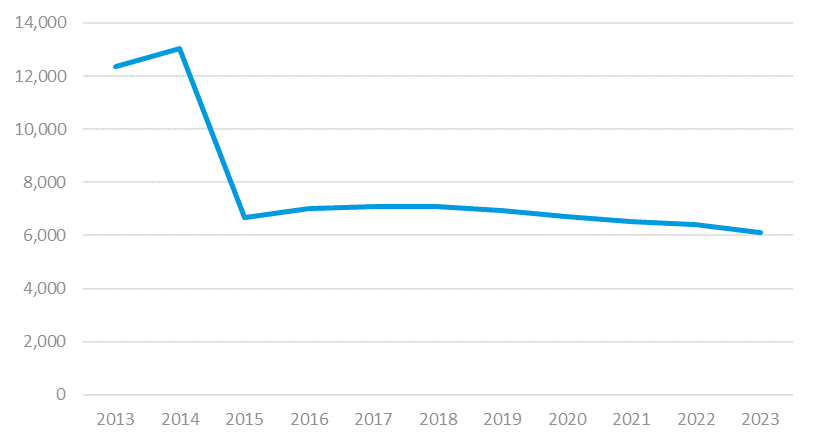
Fixed telephony service providers
Currently, FSMTC is the only provider of fixed telephone services in the FSM.
The FSM Telecommunications Market is growing, in terms of revenue. Total retail revenue, measured as revenue eligible for TRA fees, has grown seven percent from FY2021 to FY2023. Further growth is expected in FY2024.
In particular, growth has come from the Satellite Internet and Fixed Internet markets. Satellite Internet revenues have grown by 150 percent from FY2021 to FY2023. Fixed Internet revenues have grown by 9 percent from FY2021 to FY2023. Mobile revenues have declined slightly.
Total eligible market revenues
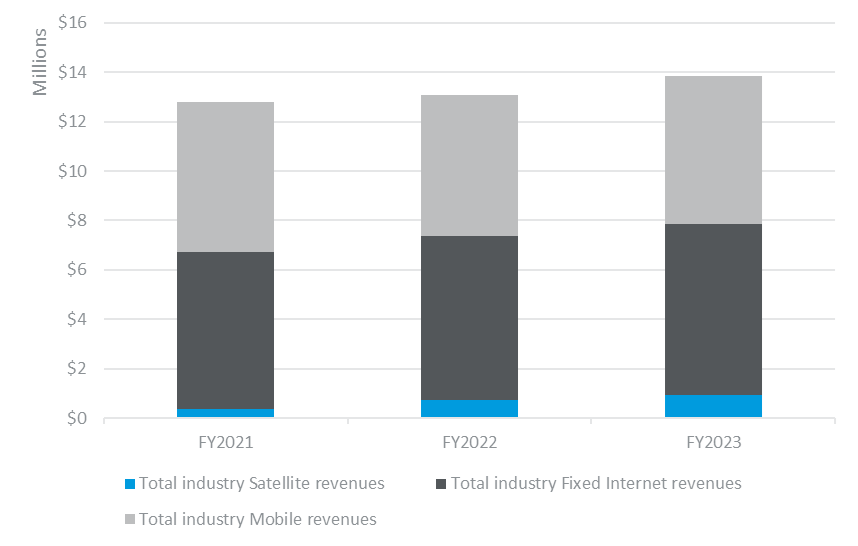
Satellite Internet
The Satellite Internet sub-market has shown strong growth in the past 3 years, with revenues growing 150 percent. Competition in the Satellite Internet sub-market is currently strong, with Kacific, MCS Pohnpei, and, as of FY2024, Starlink competing for customers.
Satellite Internet is a good alternative to fixed internet for customers who cannot connect to fiber networks.
Fixed Internet
The Fixed Internet sub-market has grown 9 percent in the past 3 years in terms of revenue. The Fixed Internet market is evolving, with FSMTC continuing to expand its own FTTP network FSM CableCorp starting to build its open access FTTP network, and iBoom operating in Yap.
The TRA expects fixed internet subscriptions and revenues to increase in the coming years as FTTP expands in all four states.
Mobile
Revenues for the Mobile sub-market have declined 1 percent over the past three years, with a larger decrease in FY2022, followed by an increase in FY2023.
The revenues reflect the story shown by user numbers, which shows that the mobile market is not growing. However, with a low penetration rate, the TRA expects there is significant room for growth in the Mobile sub-market when competition arrives.
FSM telecommunication market revenues by sub-market
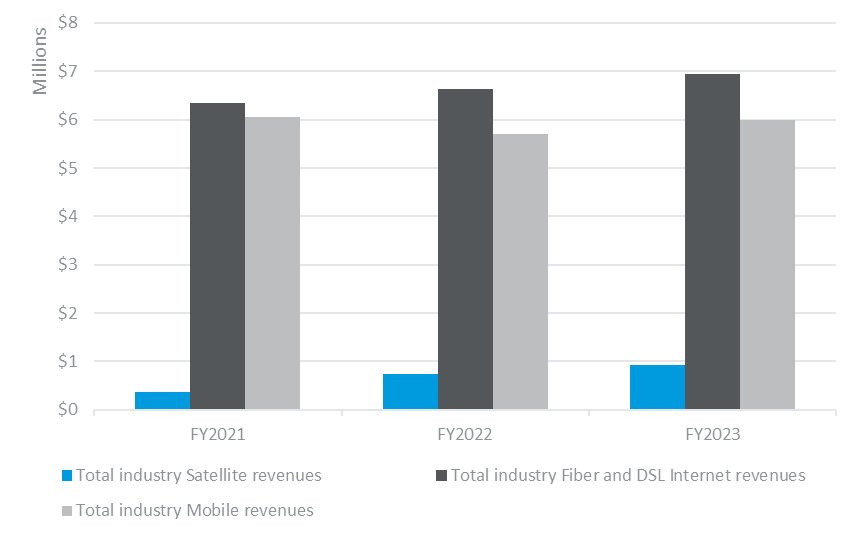
The FSM Telecommunications Market is growing, in terms of revenue. Total retail revenue, measured as revenue eligible for TRA fees, has grown seven percent from FY2021 to FY2023. Further growth is expected in FY2024.
In particular, growth has come from the Satellite Internet and Fixed Internet markets. Satellite Internet revenues have grown by 150 percent from FY2021 to FY2023. Fixed Internet revenues have grown by 9 percent from FY2021 to FY2023. Mobile revenues have declined slightly
